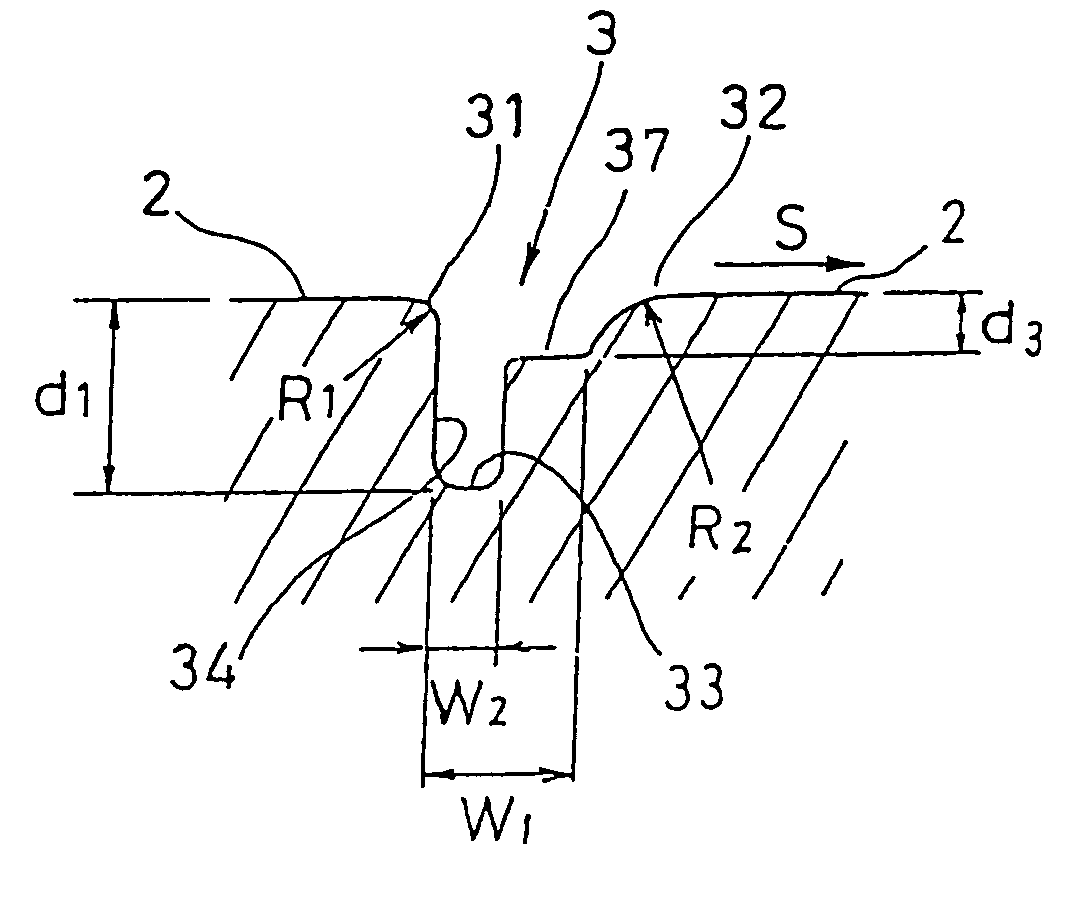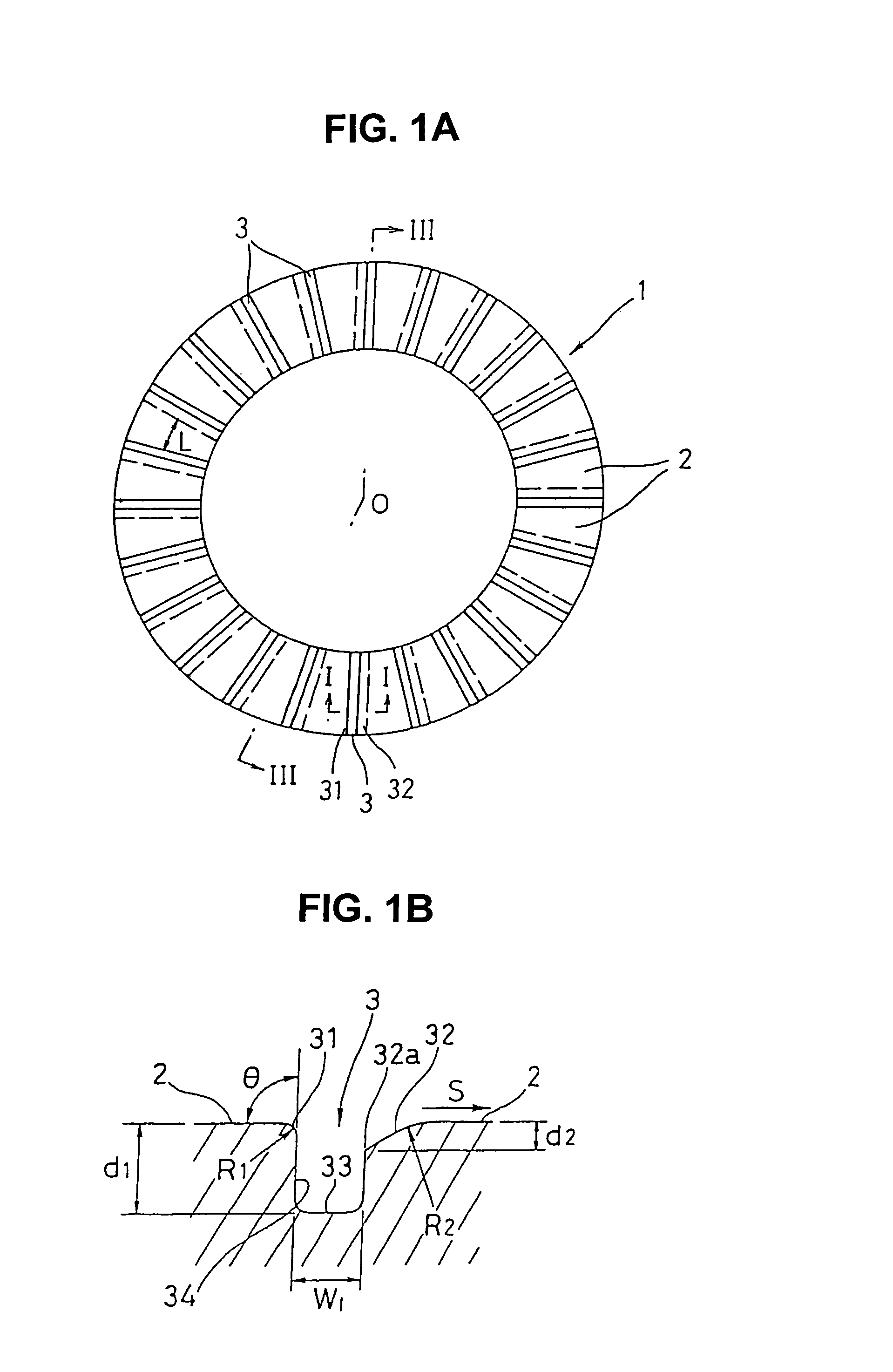Thrust bearing
a technology of thrust bearings and bearings, which is applied in the direction of sliding contact bearings, crankshafts, mechanical equipment, etc., can solve the problems of reducing the performance of torque converters, the cooling effect achieved by lubricating oil introduced into the lubricating grooves b>102/b> is not sufficient, and the copper washer is not suitable for us
- Summary
- Abstract
- Description
- Claims
- Application Information
AI Technical Summary
Benefits of technology
Problems solved by technology
Method used
Image
Examples
first embodiment
[0029]FIGS. 1A and 1B show a thrust bearing in accordance with a first embodiment, in which FIG. 1A is a front view as seen from the side of a sliding surface, and FIG. 1B is a partly enlarged cross sectional view cut along a line I—I in FIG. 1A, FIG. 2 is a back view of the same thrust bearing, and FIG. 3 is a cross sectional view cut along a line III-O-III in FIG. 1A.
[0030]A thrust bearing 1 in accordance with the present embodiment is made of a synthetic resin and formed in a flat annular shape, and is structured such as to support a thrust load of a rotation member rotating only in one direction, for example, a stator of a torque converter in an automatic transmission of a motor vehicle. The thrust bearing 1 is structured such that one end surface in the axial direction forms a sliding surface 2 with an opposing sliding member, and a lot of lubricating grooves 3 extending in the radial direction are formed on the sliding surface 2 at a predetermined interval in the circumferenti...
third embodiment
[0044]FIGS. 8A and 8B show a thrust bearing in accordance with the present invention in which FIG. 8A is a front view as seen from the side of a sliding surface. and FIG. 8B is a partly enlarged cross sectional view cut along a line VIII—VIII in FIG. 8A. The present embodiment is structured such that an angled surface 36 having a depth d2 from starting print 36a is formed in the forward side with respect to the relative rotating direction S of the opposing sliding member. Further, an opposed angled surface 35 is formed in the groove shoulder in the rearward side with respect to the relative rotating direction S of the opposing sliding member.
fourth embodiment
[0045]FIGS. 9A and 9B show a thrust bearing in accordance with the present invention, in which FIG. 9A is a front view as seen from the side of a sliding surface, and FIG. 9B is a partly enlarged cross sectional view cut along a line IX—IX in FIG. 9A. The present embodiment is structured such that a step portion 37 having a depth d3 is formed in the forward side with respect to the relative rotating direction S of the opposing sliding member. Further, in the same manner as that in FIGS. 1A and 1B, the first curved surface 31 having the radius R1 of curvature of 0.5 mm or less is formed in the groove shoulder in the rearward side with respect to the relative rotating direction S of the opposing sliding member, and the second curved surface 32 having the radius R2 of curvature which is substantially larger than the radius R1 is formed in the groove shoulder in the forward side. Further, a groove width W2 between the groove inner wall 34 and the step portion 37 is set to be about a hal...
PUM
 Login to View More
Login to View More Abstract
Description
Claims
Application Information
 Login to View More
Login to View More - R&D
- Intellectual Property
- Life Sciences
- Materials
- Tech Scout
- Unparalleled Data Quality
- Higher Quality Content
- 60% Fewer Hallucinations
Browse by: Latest US Patents, China's latest patents, Technical Efficacy Thesaurus, Application Domain, Technology Topic, Popular Technical Reports.
© 2025 PatSnap. All rights reserved.Legal|Privacy policy|Modern Slavery Act Transparency Statement|Sitemap|About US| Contact US: help@patsnap.com



